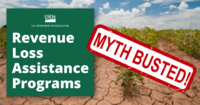
In January, we announced two new programs designed to assist producers who experienced revenue losses from 2020 and 2021 natural disasters or the COVID-19 pandemic. These programs are revenue-based and feel a little different from our regular programs, but the goal is to better support farmers.
Both the Emergency Relief Program (ERP) Phase Two and the Pandemic Assistance Revenue Program (PARP) offer a holistic approach to disaster assistance and provide economic support for producers who bear the financial brunt of circumstances beyond their control.
With the rollout of any new program, there is a learning curve for producers and employees alike. ERP Phase Two and PARP are no exception. To encourage producer participation in these valuable programs, I’m going to do my best to debunk some myths and misconceptions surrounding ERP Phase Two and PARP.
With a June 2, 2023, deadline to apply for both programs, it’s important that we clear up confusion about how to apply, what documents are required for participation, insurance requirements and related misinformation making its way across the countryside.
Now, let’s do some myth-busting.
Myth #1 – You need to submit a completed tax return to FSA to apply for ERP Phase Two or PARP.
While these programs are based on revenue losses, you do not need a tax return, completed or otherwise, to apply for assistance. In fact, we have an ERP Phase 2 tool and PARP tool that walk you through the process step by step.
We understand that you may have questions for your certified public accountant or tax preparer, who was likely been hard to reach prior to the April 18 Internal Revenue Service tax deadline but we encourage you to download the program decision tools and get started. You’ll probably discover that you already have on hand much of the information you need.
The following supporting materials will help you:
- Schedule F (Form 1040); and
-
Profit or Loss from Farming or similar tax documents for tax years 2018, 2019, 2020, 2021, and 2022 for ERP and for calendar years 2018, 2019, and 2020 for PARP.
The only reason you might have to provide your tax returns to FSA is in the event of a spot check or a request from the FSA County Committee.
Producers can register for a free webinar hosted by USDA and members of the National Farm Income Tax Extension Committee on Monday, May 1 at 2 p.m. eastern for a discussion on completing the ERP Phase Two application form.
Myth #2 – You cannot receive an ERP Phase Two payment if you received a payment under Phase One.
It’s possible that you can still receive ERP Phase Two benefits if you received an ERP Phase One payment. There is also a possibility that your Phase Two payment may be offset.
Myth #3 – ERP Phase Two was intended to be an additional payment to those who received payment under Phase One.
ERP Phase Two was never designed or intended to be an additional payment. Instead, it was intended to assist those producers who did not receive relief in Phase One.
Click here to read the full blog and view a producer testimonial on the application process.
|